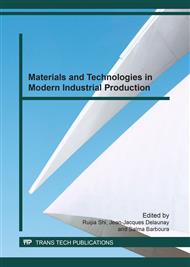[1]
W. Zhu, P. Bartos, A. Porro. Application of nanotechnology in construction. Summary of a state of the art. RILEMTC197- NCM. Mater. Struct. 37 (2004): 649 – 658.
DOI: 10.1007/bf02483294
Google Scholar
[2]
P. Pacheco Torgal, Said Jalali. Nanotechnology: Advantages and drawbacks in the field of construction and building materials. Construction and Building Materials (2011). 25: 582 – 590.
DOI: 10.1016/j.conbuildmat.2010.07.009
Google Scholar
[3]
P. Pacheco Torgal, J. A. Labrincha. Biotech cementitious materials: Some aspects of an innovative approach for concrete with enhanced durability. Construction and Building Materials 40 (2013), 1136 – 1141.
DOI: 10.1016/j.conbuildmat.2012.09.080
Google Scholar
[4]
Florence Sanchez, Konstantin Sobolev. Nanotechnology in concrete – A review. Construction and Building Materials 24 (2010), 2060 – (2071).
DOI: 10.1016/j.conbuildmat.2010.03.014
Google Scholar
[5]
L. Y. Shen, Z. Zhang. ISO 14000: the process towards sustainable construction. In proceedings of the RICS construction and building research conference, vol. 1 (1999), 254 – 262.
Google Scholar
[6]
Marta Gangolells, Miquel Casals, Santiago Gasso, Nuria Forcada, Xavier Roca, Alba Fuertes. A Methodology for predicting the severity of environmental impacts related to the construction process of residential buildings. Building and Environment 44 (2009).
DOI: 10.1016/j.buildenv.2008.05.001
Google Scholar
[7]
George Elvin. Nanotechnology and green building. Nanotechnology for Green Building, (2007) 3 – 39.
Google Scholar
[8]
Mirjana Maksimovic, M. Goran Stojanovic, Radosavljevic, Walter Smetana, Application of LTCC sensor for measuring moisture content of building materials. Construction and Building Materials 26 (2012). 327 – 333.
DOI: 10.1016/j.conbuildmat.2011.06.029
Google Scholar
[9]
Danijel Rebolj, Martin Fisher, Drew Endy, Thomas Moore, Andrej Sorgo. Can we grow buildings? Concepts and requirements for automated nano to meter scale building. Advanced Engineering Informatics 25 (2011). 390 – 398.
DOI: 10.1016/j.aei.2010.08.006
Google Scholar
[10]
E. Cartner, D. Macphee. A physico_ chemical basis for noval cementitious binders. Cem. Concre. Res., 41 (2011) , 736 – 749.
Google Scholar
[11]
Veronica Calderon, Matthieu Horgnics, Utilisation de polymères recyclés dans les mortiers et bétons. Technique de l'Ingénieur (2014).
DOI: 10.51257/a-v1-am3600
Google Scholar
[12]
Ashley Norris, Mohamed Saafi, Peter Romine, Temperature and moisture monitoring in concrete structures using embedded nanotechnology / micro electro mechanical systems (MEMS) sensors. Construction and building Materials 22 (2008), 111 – 120.
DOI: 10.1016/j.conbuildmat.2006.05.047
Google Scholar
[13]
Saurav. Application of nanotechnology in building materials. International Journal of Engineering Research and Application (IJERA), vol2. issue5, Septembre (2012), p.1077 – 1082.
Google Scholar
[14]
The constructeur. http: / the constructeur. org/concrete/ Application of nanotechnology in civil engineering. (2012).
Google Scholar
[15]
Lin Shu Wang, Peizheng Ma, Enyuanttu, David Giza – Sissou, Gregory Mueller, Nianlue Gue, A study of building envelope and thermal mass requirements for achieving thermal autonomy in an office building. Energy and Building, 78 (2014), 79 – 88.
DOI: 10.1016/j.enbuild.2014.04.015
Google Scholar
[16]
S.H. Chen and al. Investigating the properties of lightweight concrete containing high contents of recycled green building materials. Construction and Building Materials 48, (2013) 98 – 103.
DOI: 10.1016/j.conbuildmat.2013.06.040
Google Scholar
[17]
Kristine Desman. Handbook of green materials. Materials and Energy, volume5.
Google Scholar
[18]
V. Sobolov and M. Ferrada Gutierrez, How nanotechnology can change the concrete. World American Society Bulletin, n°10 (2005), 14 – 17.
Google Scholar
[19]
Zhi Ge, ZhiliGao, Application of nanotechnology and nanomaterials in construction. First International Conference On Construction In Developing Countries (ICCIDC-1). Advancing and Integrating Construction Education, Research & Practice, August 4-5 (2008).
Google Scholar


